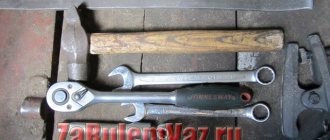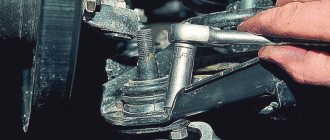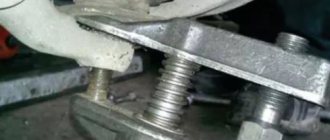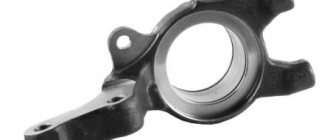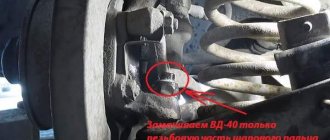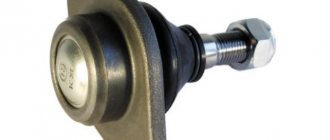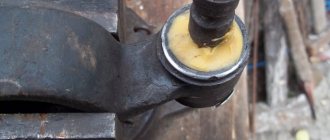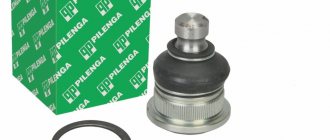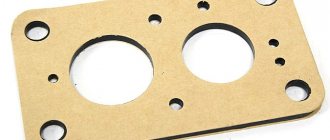Ball joints are consumables that are difficult to dismantle without special equipment.
The landing unit is constantly under force pressure, as a result of which the metal parts literally stick to each other. Universal pullers are not always suitable; the design of suspensions on different cars differs from each other.
Even in the same vehicle, different mounting designs may be used on each suspension arm. Buying several sets of equipment is too expensive, so many craftsmen prefer to make a ball joint remover with their own hands.
Puller drawings. Repair equipment. Tool
This topic will provide drawings of pullers and devices for car repairs, as well as drawings of special tools.
The following drawings are currently available:
Drawing of the front suspension strut rod nut remover.
Drawing of a universal screw puller for steering rod pins.
Drawing of spring ties for front and rear suspensions.
Drawing of a puller for pressing out the silent block of the rear suspension shock absorber.
Drawing of a puller for pressing in the silent block of the rear suspension shock absorber.
Drawing of a wheel bearing puller for the front and rear wheels.
Drills for knocking out wheel bearings
Photo of drifts for knocking out a wheel bearing
Mandrels for pressing in wheel bearings
Photo of mandrels for pressing in the wheel bearing of the front and rear wheels of VAZ-2108, VAZ-2109, VAZ-21099, VAZ-2113, VAZ-2114, VAZ-2115. The photo also shows rings from old wheel bearings, they also help with pressing.
Drawing of a puller for replacing rubber-metal hinges of the rear beam.
Replacement of rubber-metal hinges of the rear beam
Photo of the puller
Drawing of a puller for replacing the silent blocks of the front suspension arm.
Photos of the puller
Puller for replacing silent blocks of the front suspension arm
Device for compressing brake cylinders.
The brake cylinder compressor is made from old brake pads. Everything seems to be visible in the photo.
Photo of a device for compressing brake cylinders.
Drawing of brake cylinder compression device
Source
Video.
Ball joints are consumables that are difficult to dismantle without special equipment.
The landing unit is constantly under force pressure, as a result of which the metal parts literally stick to each other. Universal pullers are not always suitable; the design of suspensions on different cars differs from each other. Even in the same vehicle, different mounting designs may be used on each suspension arm. Buying several sets of equipment is too expensive, so many craftsmen prefer to make a ball joint remover with their own hands.
DIY ball joint remover: instructions and materials
When repairing the chassis of any car, it becomes necessary to remove steering rods or ball joints. In both cases, their tip has a conical shape, which ensures optimal fit of the products in the socket. During operation, they become very compact, and if moisture gets between them, then corrosion forms at their joints. It makes it even more difficult to separate these parts.
To make repair work easier, a do-it-yourself ball joint remover would be an excellent option, which will greatly simplify the repair and help remove the tip with little effort.
When and how to change supports?
Replacing a worn metal joint in a car is akin to an operation to put in order a living “hinge” that has been worn out during a long life of “operation”. However, the presence of a surgeon is not at all necessary here; replacing a ball joint on a personal car is available to any owner, although this is not a very pleasant procedure.
The first trouble is that the ball joint does not simply break. Usually such a vile incident occurs at the most inopportune moment, for example, when the driver, and even his entire family, are transporting a refrigerator on the roof of a Zhiguli, and while turning or going around some obstacle, the car suddenly “sags” to one side with a crash. That is, the first condition for failure is an excessive load on the hinges. To prevent the occurrence of such cases, periodic diagnostics of the chassis are needed.
Broken ball joint
If there is the slightest suspicion that the ball joints are faulty, the check can be carried out in three main ways.
- After jacking up the “suspicious” wheel, grab it by the upper and lower parts and shake it significantly. If there is play, it's time to change the support.
- If there is a repair pit or overpass, take a pry bar and, positioned under the bottom of the car, place it between the edge of the ball joint and the lower steering control arm. Try pressing up. There should be no backlash here either.
- The most accurate way (albeit the most labor-intensive) is to remove the support, hold it in a vice and try to move the ball pin in different directions with your hand. If you can do this easily, the part has become unusable and requires urgent replacement.
This is precisely the third method that will be discussed, since, having established the fact of the need for replacement, a special puller is required, with the help of which it will be necessary to unpress the ball pin.
Why do you need a ball joint remover?
Without it, it is difficult to dismantle and carry out repair work on the chassis of the car; a puller may also be needed to disassemble the steering joints . It can be used for ball joints of different diameters. When choosing its design, they rely on the technical characteristics of a particular car.
Theoretically, the dismantling of ball joints can be carried out with any available tool, using a sledgehammer or hammer, but such repairs are classified as “stressful”.
Types
The modern market for tools for car maintenance and repair offers the widest selection of different pullers, including several types of tools for dismantling ball joints and steering rods.
The ball joint puller can be:
- Screw.
- Lever.
The first devices are considered a more universal solution. They are suitable for servicing any car.
What does a puller look like?
There are three types of pullers :
They differ in appearance, but their operating principle is the same. The finger is twisted out of its seat using a hammer or by turning the nut . The puller is designed in such a way that it fills the space between the connected parts and after turning it you can hear a click, indicating that the connection has loosened and you can remove the ball joint from its seat.
The puller helps even a novice in auto repair work to dismantle it.
Which puller is better?
In the video you can see several options for ball pullers , among them the screw one , but only it must be made with high quality.
Its analogue in the form of a fork is universal, since it can be used not only for ball joints, it also helps when removing steering ends. However, its work can negatively affect the anthers.
There are difficult cases when you have to work with a puller and a hammer in pairs: first, the supports are pushed apart with a screw, and then you need to strike with a sledgehammer.
Make or buy?
Ball joint end pullers for domestic cars cost no more than 1000 rubles. You can purchase the device at any store. This means that the instrument is easier and easier to acquire. To make even the simplest tool, you need blanks, special nuts and bolts with a large thread pitch.
It is easier to purchase a ready-made tool because it saves time. You won't have to do unnecessary things. Perhaps purchasing a device will cost a little more, but then there is no need to waste time and effort on making the tool.
Step-by-step manufacturing instructions
The device for removing ball joints is quite complicated, but if you follow the step-by-step instructions, you can do it yourself:
The finished device is suitable for emergency and planned replacement of ball joints on Zhiguli and Lanos, as well as some brands of foreign manufacturers.
The manufactured puller is not universal and cannot be used for different components, but if you succeeded in doing it the first time, then subsequent versions will be much easier.
For 15 years I have been repairing various types of cars, including brands such as VAZ, UAZ, Chevrolet, Mazda, Kia and many others. Everything related to the gearbox, engine or chassis. You can write me your question below in the comments and I will try to answer it in detail.
Source
We buy spare parts
The selection of spare parts is carried out according to the VIN code of your car, which eliminates selection errors
But it wouldn’t hurt to play it safe and pay attention to the ball joint during diagnostics. On some vehicles, the left support is different from the right
When choosing a manufacturer, we listen to the seller’s recommendations. The price-quality ratio must be satisfactory. The ball joint is an important suspension element that affects driving safety, so you should not skimp on it.
Front left and right ball joints on Toyota Corolla EE90
Depending on the manufacturer, a set of new mounting bolts and nuts may be included with the ball joint.
A very important point! Old fasteners quite often “sour”, which causes difficulties during dismantling. Sometimes, you can only unscrew them by deforming them. Cut threads, broken bolts, and torn edges can force you to go to the store in the middle of repair work, leaving the car disassembled. If the kit does not include new hardware, we ask where they can be purchased and whether it is possible to return the product if it is no longer needed.
Tools for work.
To replace the ball, you will need to prepare. To do this you need:
- Keys and gates.
- Liquid WD-40.
- Litol or ShRB lubricant.
- Puller.
- Hammer and crowbar.
The ball joint connects the lever and the steering knuckle.
It is used to attach the lever to the hub.
Replacement time
When driving a car on a bad road, you will need to change the ball joints often.
- Initially, when it fails, a knock will be heard.
- Then the car will begin to pull to the side even when driving on a good road.
- Then the tires will begin to wear unevenly.
- When turning the steering wheel, squeaks may appear.
- It will become more difficult to turn the wheels.
If the finger moves freely with little hand force, the ball joint requires replacement.
Replacement
The whole process is carried out in the following stages:
- Removal. Hang the wheel, unscrew the nut on the pin, then knock the rod out of the socket.
Unscrew the 2 bolts securing the ball to the knuckle.
If there is no puller, insert the assembly and knock out the lever with a hammer.
Installation
Before installation, fill the case with lubricant.
You just need to insert your finger into the socket and tighten the nut on it. You should definitely lubricate the ball inside under the boot.
How to make a ball joint remover with your own hands
When carrying out repairs to the chassis and steering, there is almost always a need to remove ball joints or tie rod ends.
The peculiarity of these structural elements is that the support pin or tip has a conical shape, with which it fits into the seat.
During operation, the fit density increases so much that the surfaces of this joint practically stick to each other.
Additionally, moisture can get between the finger and the socket, causing pockets of corrosion that further seal the connection.
Therefore, to remove ball joints or tips, special pullers are used that allow you to press out the pin with minimal effort.
How can a puller help us?
Why is the puller given such attention when replacing a ball joint? The fact is that the service life of this part is quite long, and its components “stick” to each other as a result of heating, friction and corrosion. In particular, a fairly common occurrence is “welding” of the cone and socket. Simple tools that are found in a regular car repair kit may not include a puller. Some craftsmen very simply cut this “Gordian knot” using a sledgehammer and a gas torch. But such a decision may threaten that the steering rods will also have to be changed.
In order not to resort to barbaric methods, you should take care in advance of purchasing a ball joint remover. Fortunately, their cost is adequate, there are a great many options for devices, and therefore there are no problems. But not everyone is ready to spend money on a tool that, although useful, can be useful only once during the entire period of car ownership.
The principle that underlies any tool designed to remove a ball pin from a pressed socket is the ability to overcome a fairly significant force that prevents it. Over the years of its existence, humanity has not invented anything better than a lever and a screw, which are the basis of any puller. In addition to these textbook devices, the instrument must have a wedge. If anyone has seen a nail puller, they will understand what we are talking about.
Tool for removing ball pin from pressed socket
It’s just inconvenient to use such a device, helping it with a hammer to “crawl” into the space between the head of the “ball” and the socket. With almost 100% probability the rubber boot will be torn. That is why other engineering solutions come to the rescue, helping to remove the finger neatly and beautifully.
A hybrid of a nail puller and a small clamp can be considered a tool that carefully removes a ball pin from its socket without damaging anything around it. Using the first, metal “legs” are brought under the “ball”. The second device, integral with the first, is designed to accurately separate the part from the socket. This is achieved by gradually tightening the knob, pressing on the finger itself and gradually separating it from the body. By the way, sometimes homemade devices cope with their task much better than purchased ones, and anyone who has at least some plumbing skills will certainly be able to make it with their own hands.
On price tags in stores you can also see the word “universal” in relation to the puller. There are few special features here; the structure allows it to be used not only for pressing out ball joints, but also for working with steering ends. Making such a device with your own hands is much more difficult; here it is better to resort to mass-produced products or take a universal tool from friends.
Types of pullers
The auto tools market offers a wide selection of such removable mechanisms, which can be divided into two types:
Screw pullers are considered universal and are suitable for working with almost any car.
The force in them is created by screwing the bolt into the puller body. The housing itself is put on the support eye, and when tightened, the bolt rests against the support pin and presses it out of the socket.
Lever removable mechanisms are no less effective, but they are larger in size, so they may not be suitable for every car.
For example, with such a puller on a VAZ-2107 you can still remove the upper ball joint, but you won’t be able to get to the lower one due to very limited space.
For these purposes, a special puller is used.
The essence of a lever puller comes down to the presence of two levers connected in the middle.
On the one hand, holes are made in them and a coupling bolt is installed.
To press out, one lever is installed between the eye and the support, while the second lever is placed under the finger.
When the bolt is unscrewed, due to the existing connecting axis, the ends of the levers begin to converge and the pin is pushed out.
But it is not necessary to purchase a removable mechanism; it can easily be made at home from improvised materials.
Next, we’ll look at several types of ball joint and steering wheel pullers that you can make yourself.
Wedge type puller (or fork)
The illustration shows the factory version. Working with such a puller requires physical effort. The longer the lever, the easier it is to dismantle the hinge.
The principle of operation is simple: a wedge is driven between the ball body and the suspension arm, then the lever is used to tear off the shank from the seat.
A serious drawback of the device is the possibility of damage to the suspension arm. The ball joint boot also breaks, so it cannot be reused.
Such a puller can be made from a 12-16 mm steel circle. You will need a welding machine and the work of a blacksmith. It is better to give the wedge-shaped “fork” using forging: if you simply grind off the metal, the strength will be lost.
After final processing of a homemade puller, it must be hardened. The steel is heated to a crimson color and immersed in water or oil.
Screw release mechanism
The second type of removable mechanism, which can be made from improvised means, is a screw release mechanism. It is perfect for replacing ball joints of classic VAZ models.
A special feature of the suspension design of these cars is that the upper and lower supports are located symmetrically to each other and the distance between them is not large.
It can be made at home only if you have a drilling machine, or you will have to go to a lathe. This puller consists of only two parts.
To make it, you will need a square or hexagonal rod with 17 or 19 key edges, the length of which is 7 cm. Using a drilling machine, we make a hole in this rod and cut a thread for a bolt of 8. Screw in the bolt and that’s it - the puller is ready.
Let's look at how it works using the VAZ-2107 as an example. To press out the upper support, you need to unscrew the lock nut, but not completely, you do not need to remove it. Then we install the manufactured puller between the pins of the supports with the bolt screwed in until it stops.
To squeeze out the finger, we take two keys - with one we hold the manufactured body, and with the second we unscrew the bolt until the finger falls off the socket. After replacing the upper support, we do the same, but with the lower one.
Choosing a quality ball
You can buy any ball joint at the nearest store and drive it for quite a long time, but this is a matter of chance. Therefore, let's look at what a high-quality ball should be:
- Ball joint housing. It must be welded in two parts. The seam should be visible on one side, but not on the other.
- Ball joint pin. Must be hardened, gray in color, must have scale and no paint on it. Rolled thread.
- The ball should rotate with great effort, but not bite. It is often very difficult to turn the finger with your hands - you have to take a knob.
- The kit should include a boot and a nut.
- Remember - most VAZ 2110 owners install Track balls on their car. Also good options are BelMag, Trial-Lux and others.
Screw L-shaped
The third type of removable mechanism, which you can make yourself, is also a screw mechanism, but it has shown itself to be excellent and allows you to work on any car.
To make it you will need a round metal rod with a diameter of at least 10 mm and a length of 15-17 cm.
From it you need to make an L-shaped blank with a shoulder length of 5 cm. That is, we take a rod, measure 5 cm on it, clamp it in a vice and use a hammer to bend it 90 degrees.
We cut a thread on the long part of the workpiece and select a nut.
All that remains is to make the thrust bar. It can be made in the likeness of the wedge described above. That is, we take a plate, but 0.5 cm thick. On one side we make a cut for the support pin.
If necessary, you can reduce the thickness of the plate on the cut side by grinding off the metal layer. The main thing is that the plate fits into the gap between the support body and the eye, but it is not too thin, otherwise it will bend during the pressing process.
On the other hand, from the cut we make a hole for the L-shaped workpiece. All that remains is to put the plate on the long part of the rod. If the thread is not long enough to squeeze out the finger, you can place several washers under the nut.
Wedge
This is the simplest and yet quite effective puller. It cannot be classified as any type of mechanism, but in matters of pressing out it is a good choice. To make it, you only need a grinder or a machine with an abrasive wheel. The blank is a metal plate, the dimensions of which are similar to a box of matches.
First, the metal platinum is shaped into a so-called wedge - the metal is ground down so that the profile of the part is triangular. Next, using a grinder or using a machine, a cutout is made in the middle. Its length should be approximately 2/3 of the plate. The cut is made from the thin side. The width of the cutout is made greater than the thickness of the support on the finger. The result should be something like a staple.
Then a rod is welded to this bracket. This will allow you to use a ball joint remover. Working with a wedge is quite simple. It is installed in the gap that exists between the eyelet and the body of the ball pore. Then, using a hammer, the wedge is driven in, which leads to the pin being pressed out.
But there is a significant drawback when working with this tool. During the process of pressing out the support, the boot is damaged. That is why the wedge is used only when replacing tips or supports. It is better to avoid repairs using such a device.
Screw made from angle
Another screw puller can be made from a metal angle and a welding machine.
To do this, take a corner with sides 7-8 cm and the same length, and a thickness of 0.3-0.5 cm.
We make a cut in one of the sides to secure the mechanism to the eye. From sheet metal 0.3 cm thick we cut out two triangles that will act as braces. They need to be welded on the sides to the corner. This will significantly increase the strength of the structure.
We take a 17 nut and a long bolt for it. We weld the nut itself perpendicular to the cut so that its hole faces the cut.
So that in the future the bolt can be easily positioned on the same axis with the pin, before securing the nut by welding, a spacer must first be welded onto the corner.
All that remains is to screw in the bolt and the puller can be used.
These are the simplest types of removable mechanisms that you can make yourself.
In general, there are a lot of options, and with a little imagination and basic knowledge of plumbing, you can easily come up with and make your own puller.
We offer some drawings for viewing.
Tool for unscrewing the support
We will consider another type, which is used not for pressing out the finger, but for removing the support itself.
The fact is that on a number of cars (Peugeot, Citroen) the ball joint is screwed into the lever. Over time, the threaded connection sours, and it is quite difficult to unscrew this suspension element without a special tool.
But you can make the necessary puller yourself, rather than spending money on a factory one.
It is made from a thick-walled pipe 2\'\' 8-9 cm long.
At the end of this pipe it is necessary to make 4 spikes with a width of 5 mm and a height of 7 mm, located at an angle of 90 degrees relative to each other.
That is, you should get 4 protrusions at the end of the pipe, evenly distributed around the circumference. This can be done using a hacksaw and a file, or with a grinder.
From the other end we make slits to a depth of 3 cm, dividing the circumference of the pipe into 8 parts.
Then we bend these petals to the center using a hammer, significantly reducing the diameter.
We take a 24mm nut and screw it to the end part, and then use a welding machine to seal the slots made.
It is quite convenient to work with such a puller - we put it on the support so that the spikes fit into special grooves on the support body.
In this case, the finger will pass through the manufactured tool, which will allow the locking nut to be screwed onto it, thereby securing the puller. All that remains is to use a 24mm wrench to unscrew the support using the welded nut.
How to diagnose a problem
To diagnose a wheel bearing malfunction, you can use the help of a car service center, or you can do it yourself. Diagnosis occurs as follows.
We install the machine on level ground, and then check the vertical play. To do this, jack up the front suspension. Then we put our hand on the top of the wheel and make movements from ourselves to ourselves. The failure of the consumable will be indicated by a clicking sound.
You can use one more method to check. We jack up the vehicle's control arms. We start the car, accelerate the wheels, and then abruptly stop. The failed element will be located on the side where the hum-like noise comes from.
If the problem has already started, then a grinding noise will be heard even if the wheel on a car raised with a jack is turned manually clockwise. In addition, when the wheel spins, strong play will be clearly visible.
Alternative method
Finally, we note that it is possible to press out the support pin or tip even if it is not possible to make a removable mechanism. But this method should be used only in extreme cases. To remove the finger you will need a pry bar and a hammer.
The pry bar is used as a lever and must be installed in such a way as to create a force to press the support or tip, for example, place it between the steering rod and the rack eye.
After creating force with the mount, it is necessary to apply powerful blows to the body of the eye with a hammer. If everything is done correctly, then after 2-3 hits the finger will pop out.
The disadvantage of this method is that the eye can be damaged due to shock loads, so it is advisable to use pullers rather than knock out the support.
Source
When does a wheel bearing need to be replaced?
This part is quite durable, but it is not able to withstand operation for a long time in the harsh conditions of Russian roads. Therefore, over time, replacing the Chevrolet Lacetti bearing becomes a necessity.
Its malfunction can be easily determined without the intervention of specialists. Symptoms may include:
- Crunchy sound. If the bearing begins to deteriorate, then a noise resembling a crunching sound will definitely appear in the wheel area. This occurs because the bearing shell breaks and its spherical elements begin to roll randomly.
- The salon began to vibrate. If the wheel bearing is worn out, the steering wheel vibrates strongly. This already indicates that the element has completely become unusable.
- The car starts to pull away. When a consumable fails, you get a persistent feeling that something is holding the car while moving. And while driving at high speed, the car begins to pull to the side.
A worn part must be immediately replaced as soon as a fault is discovered
It is important to remember that any damage to the chassis is very serious, and work to eliminate them should not be postponed.
